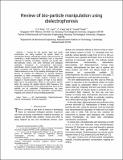| dc.description.abstract | During the last decade, large and costly instruments are being replaced by system based on microfluidic devices. Microfluidic devices hold the promise of combining a small analytical laboratory onto a chip-sized substrate to identify, immobilize, separate, and purify cells, bio-molecules, toxins, and other chemical and biological materials. Compared to conventional instruments, microfluidic devices would perform these tasks faster with higher sensitivity and efficiency, and greater affordability. Dielectrophoresis is one of the enabling technologies for these devices. It exploits the differences in particle dielectric properties to allow manipulation and characterization of particles suspended in a fluidic medium. Particles can be trapped or moved between regions of high or low electric fields due to the polarization effects in non-uniform electric fields. By varying the applied electric field frequency, the magnitude and direction of the dielectrophoretic force on the particle can be controlled. Dielectrophoresis has been successfully demonstrated in the separation, transportation, trapping, and sorting of various biological particles. | en |
